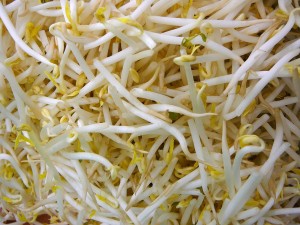Mung bean sprouts, typically consumed raw or minimally cooked, are often contaminated with pathogens. Internalized pathogens pose a high risk because conventional sanitization methods are ineffective for their inactivation. The studies were performed (i) to understand the potential of internalization of Salmonella in mung bean sprouts under conditions where the irrigation water was contaminated and (ii) to determine if pre- and postharvest intervention methods are effective in inactivating the internalized pathogen. Mung bean sprouts were grown hydroponically and  exposed to green fluorescence protein–tagged Salmonella Typhimurium through maturity. One experimental set received contaminated water daily, while other sets received contaminated water on a single day at different times. For preharvest intervention, irrigation water was exposed to UV, and for postharvest intervention–contaminated sprouts were subjected to a chlorine wash and UV light. Harvested samples were disinfected with ethanol and AgNO3 to differentiate surface-associate pathogens from the internalized ones. The internalized Salmonella Typhimurium in each set was quantified using the plate count method. Internalized Salmonella Typhimurium was detected at levels of 2.0 to 5.1 log CFU/g under all conditions. Continuous exposure to contaminated water during the entire period generated significantly higher levels of Salmonella Typhimurium internalization than sets receiving contaminated water for only a single day (P < 0.05). Preintervention methods lowered the level of internalized Salmonella by 1.84 log CFU/g (P < 0.05), whereas postintervention methods were ineffective in eliminating internalized pathogens. Preintervention did not completely inactivate bacteria in sprouts and demonstrated that the remaining Salmonella Typhimurium in water became more resistant to UV. Because postharvest intervention methods are ineffective, proper procedures for maintaining clean irrigation water must be followed throughout production in a hydroponic system.
exposed to green fluorescence protein–tagged Salmonella Typhimurium through maturity. One experimental set received contaminated water daily, while other sets received contaminated water on a single day at different times. For preharvest intervention, irrigation water was exposed to UV, and for postharvest intervention–contaminated sprouts were subjected to a chlorine wash and UV light. Harvested samples were disinfected with ethanol and AgNO3 to differentiate surface-associate pathogens from the internalized ones. The internalized Salmonella Typhimurium in each set was quantified using the plate count method. Internalized Salmonella Typhimurium was detected at levels of 2.0 to 5.1 log CFU/g under all conditions. Continuous exposure to contaminated water during the entire period generated significantly higher levels of Salmonella Typhimurium internalization than sets receiving contaminated water for only a single day (P < 0.05). Preintervention methods lowered the level of internalized Salmonella by 1.84 log CFU/g (P < 0.05), whereas postintervention methods were ineffective in eliminating internalized pathogens. Preintervention did not completely inactivate bacteria in sprouts and demonstrated that the remaining Salmonella Typhimurium in water became more resistant to UV. Because postharvest intervention methods are ineffective, proper procedures for maintaining clean irrigation water must be followed throughout production in a hydroponic system.
Journal of Food Protection®, Number 5, May 2014, pp. 696-863 , pp. 752-757(6)
Ge, Chongtao1; Rymut, Susan1; Lee, Cheonghoon2; Lee, Jiyoung3
